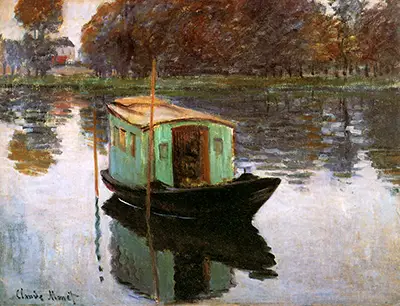In the middle of leaving London and moving to Argenteuil in 1871, the craftsman ventured out to Holland for a short time on the proposal of Daubigng, who had lauded the ideals of this place where there are light and water.
When he finally returned to France, the artist again took after Doubigng's case and searched for a riverboat to change over into a floating studio.
Amid Monet's look around Argenteuil for such art, he met Gustove Caillebotte, a well-off youthful boot buff. Together they discovered his gliding studio, which at that point turned into the subject of a gathering of four works of art.
The studio boat was painted in the late spring of 1874 at a time when Monet was living in the small town of Argenteuil, near the Seine somewhere in the range of seven miles going north of Paris.
They demonstrate Monet and his better half seated in a little vessel, the bateau-atelier from which the craftsman executed a significant number of his perspectives of the Seine at Argenteuil.
The paintings were done in consequence of the major Impressionist show held in Paris between April 15 and May 15, 1874, where Monet and a number of famous craftsmen were present including Degas, Pissarro, and Renoir, among others; yet Manet was absent.
He is sitting in a canvassed sailboat amidst the day painting a representation of a lady who could be his significant other. I see the mechanical zone on the opposite side of the water with smoke gushing from the smokestacks.
There are houses on the banks. In the work of art apparently, the topic or Claude Monet jumped at the chance to paint in the outside perhaps on the water is the place he gets his general quietness.
This is such an essential however delightful piece. I feel quiet when taking a gander at this article. It sees a great deal of peacefulness. I see a youthful painter painting his guide at work. I know extravagance in the dress of the man and nature of his action and sailboat.
The man is by all accounts settled and agreeable in his work. The hues showed in crafted by craftsmanship are light blues, some neutral tones, for example, and some green. Dull blues are characterizing the base of the watercraft and in the water correctly underneath the vessel. The craftsman is dressed coolly in a white shirt and tan khaki.
The material utilized here is oil on canvas. What's more, the method used is putting hues specifically on a white canvas with no preparatory portray. The work of art highlights Claude Monet as the topic has short brush strokes and shows the impression of light on water.
The Studio Boat recounts the narrative of Monet and his association with water. On the studio vessel, floating on the Seine is the nearest to water Monet has ever been.
The studio pontoon gave the painter a break from advancement amid his last a long time in the small town when the residential community outside Paris began to end up plainly excessively industrialized for the craftsman's optimal.


